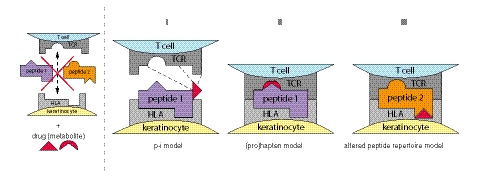Figure 2.

Proposed models of drug‐mediated TCR‐HLA interaction in EN. HLA molecules expressed on the membrane of antigen‐presenting cells (APCs – here keratinocyte) show specificity for peptides they can present. Subsequently, the HLA‐peptide complex is recognized by a specific T‐cell receptor (TCR) on the T‐cell membrane. Peptides 1 and 2 cannot bind the TCR and HLA depicted constituting a TCR‐HLA interaction, unless a drug (metabolite) is present and an interaction is made following one of these three models: I) The (pro)hapten model involves covalent binding of the drug or its metabolite during intracellular peptide processing, forming a novel HLA‐peptide complex that is recognized by a TCR. II) In the pharmacological interaction (p‐i) model, the drug binds non‐covalently to either the TCR or HLA molecule, enabling the formation of an unusual TCR‐HLA complex. III) The altered peptide repertoire model consists of the drug binding to the HLA peptide‐binding groove, changing the range of peptides the HLA molecule can present and thus altering the recognition by TCRs.
